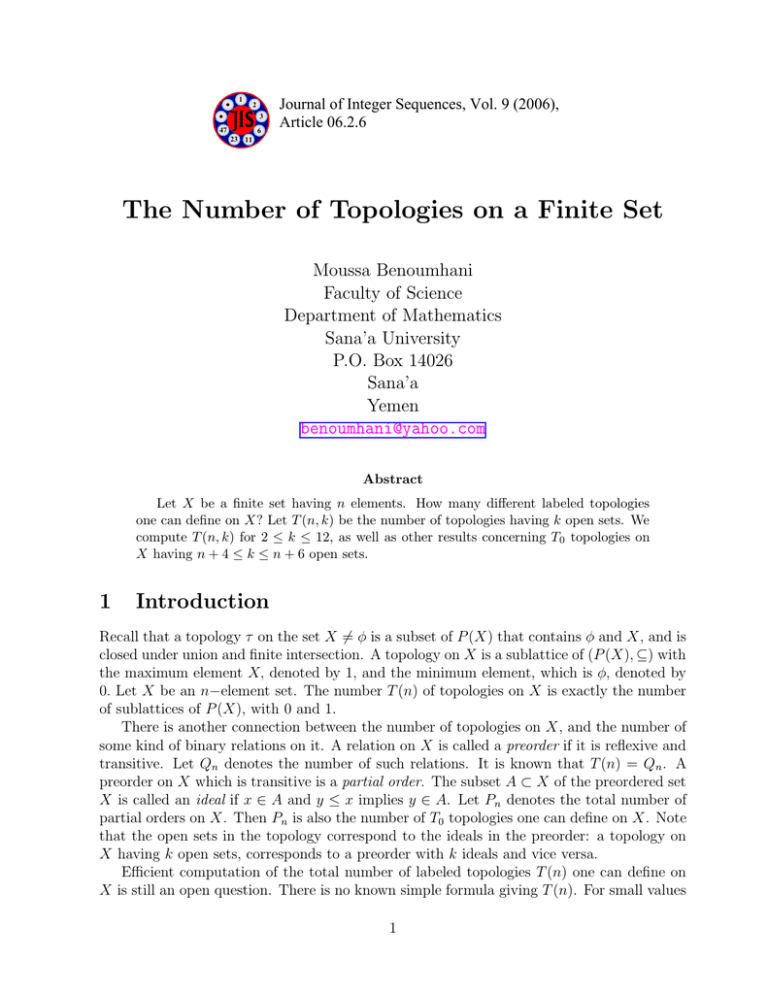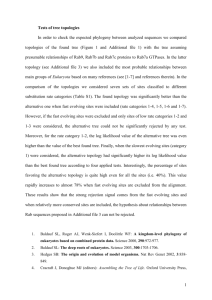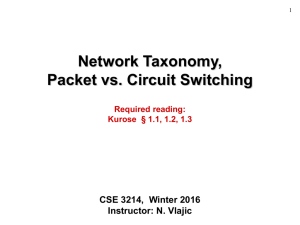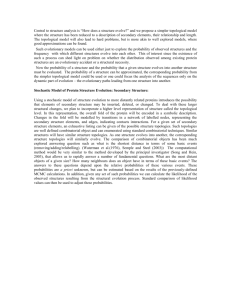The Number of Topologies on a Finite Set
advertisement

1
2
3
47
6
Journal of Integer Sequences, Vol. 9 (2006),
Article 06.2.6
23 11
The Number of Topologies on a Finite Set
Moussa Benoumhani
Faculty of Science
Department of Mathematics
Sana’a University
P.O. Box 14026
Sana’a
Yemen
benoumhani@yahoo.com
Abstract
Let X be a finite set having n elements. How many different labeled topologies
one can define on X? Let T (n, k) be the number of topologies having k open sets. We
compute T (n, k) for 2 ≤ k ≤ 12, as well as other results concerning T0 topologies on
X having n + 4 ≤ k ≤ n + 6 open sets.
1
Introduction
Recall that a topology τ on the set X 6= φ is a subset of P (X) that contains φ and X, and is
closed under union and finite intersection. A topology on X is a sublattice of (P (X), ⊆) with
the maximum element X, denoted by 1, and the minimum element, which is φ, denoted by
0. Let X be an n−element set. The number T (n) of topologies on X is exactly the number
of sublattices of P (X), with 0 and 1.
There is another connection between the number of topologies on X, and the number of
some kind of binary relations on it. A relation on X is called a preorder if it is reflexive and
transitive. Let Qn denotes the number of such relations. It is known that T (n) = Qn . A
preorder on X which is transitive is a partial order. The subset A ⊂ X of the preordered set
X is called an ideal if x ∈ A and y ≤ x implies y ∈ A. Let Pn denotes the total number of
partial orders on X. Then Pn is also the number of T0 topologies one can define on X. Note
that the open sets in the topology correspond to the ideals in the preorder: a topology on
X having k open sets, corresponds to a preorder with k ideals and vice versa.
Efficient computation of the total number of labeled topologies T (n) one can define on
X is still an open question. There is no known simple formula giving T (n). For small values
1
of n, this may be done by hand; for example, T (1) = 1, T (2) = 4, and T (3) = 29. For n ≥ 4,
the calculations are complicated. The online encyclopedia of N. J. A. Sloane [2] gives the
value of T (n) for 1 ≤ n ≤ 14.
An approach towards the determination of T (n) is as follows. Let t(n, k) be the set of
all labeled topologies on X and having k open sets (or, which is the same, the P
number of
n
preorders on X having k ideals), 2 ≤ k ≤ 2 , and T (n, k) = |t(n, k)|. So, T (n) =
T (n, k).
k≥2
Obviously, we have
T (n, 2) = T (n, 2n ) = 1
T (n, 3) = 2n − 2
For k ≥ 4, the determination of T (n, k) is not as straightforward as for T (n, 2) and T (n, 3).
The numbers T (n, k) have been determined for some values of k. For instance, R. Stanley [3]
computed T (n, k) for large values of k, viz.; 3 · 2n−3 < k < 2n . Also, he determined labeled
T0 topologies on X having either n + 1, n + 2, or n + 3 open sets.
In this paper, we compute T (n, k) for 2 ≤ k ≤ 12, as well as the total number of labeled
T0 topologies on X having n + 4, n + 5, n + 6 open sets. We also give different proofs (shorter
or simpler) of some known results in [1, 3, 2].
We need some preliminary definitions and results. Let us recall the definition of Stirling
numbers of the second kind:
Definition 1.1. The number of partitions of a finite set with n elements into k blocks, is
the Stirling number of the second kind. It is denoted S(n, k).
The explicit, and somewhat complicated formula for Stirling numbers of the second kind
is
k
S(n, k) = Sn, k
1 X
=
(−1)j
k! j=0
µ
k
j
¶
(k − j)n .
(1)
Lemma 1.2. Let τ be a topology on a finite set X. Then τ c = {Ac , A ∈ τ } is also a topology
on X.
Remark 1.3. The previous lemma is not necessarily true if X is infinite. Note, also, if τ is
a topology, it may happen that τ = τ c . Take X = {a, b, c}, and τ = {φ, X, {a}, {b, c}}.
Definition 1.4. A chain topology on X, is a topology whose open sets are totally ordered by
inclusion.
2
Topologies with small number of open sets
In this section we compute T (n, k) for 2 ≤ k ≤ 12. We need the following lemma
Lemma 2.1. (D. Stephen) Let C(n, k) be the number of chain topologies on X having k
open sets. Then
C(n, k) =
n−1 ³ ´
X
n
l=1
l
C(l, k − 1) = (k − 1)!S(n, k − 1)
2
(2)
Proof. This proof is shorter than that in Stephen [4]. First, there is a bijective correspondence between the k−ordered partitions (partitions having k blocks) of the set X and
the chains of subsets of X having k (non empty and different from X) members: the chain
φ 6= A1 $ A2 $ A3 . . . $ Ak $ X, is associated with the partition (B1 , B2, B3, . . . Bk ), where
B1 = A1 , Bi = Ai − Ai−1 , Ak+1 = X − Ak . In the other hand, if (B1 , B2, B3, . . . Bk ) is an
ordered partition, the chain φ 6= A1 $ A2 $ A3 . . . $ Ak− $ X, where A1 = B1 , Ai =
Ai−1 ∪ Bi , 2 ≤ i ≤ k − 1, is associated with the partition (B1 , B2, B3, . . . Bk ). Now the
cardinal of the ordered k-partitions is k!S(n, k), which is the desired result.
For the recursion, note that a chain topology on a subset A ⊆ X, 1 ≤ |A| = l ≤ n − 1,
having k − 1 open sets, is a chain topology on X with k open sets. The total number of such
n−l
¡ ¢
P ¡n¢
C(l, k − 1). ¥
topologies on A is nl C(l, k − 1). So, C(n, k =
l
l=1
Now we are ready to prove our main result.
Theorem 2.2. For every n ≥ 1, we have
T (n, 4) = Sn, 2 + 3!Sn, 3 = 3n − 5 · 2n−1 + 2
T (n, 5) = 3!Sn, 3 + 4!Sn, 4 = 4n − 3n+1 + 3 · 2n − 1
3
T (n, 6) = 3!Sn, 3 + 4!Sn, 4 + 5!Sn, 5
2
9
.4!Sn, 4 + 2.5!Sn, 5 + 6!Sn, 6
T (n, 7) =
4
15
5
T (n, 8) = Sn, 3 + 2.4!Sn, 4 + .5!Sn, 5 + .6!Sn, 6 + 7!Sn, 7
4
2
11
5
4!Sn, 4 + 5.5!Sn, 5 + 6!Sn, 6 + 3.7!Sn, 7 + 8!Sn, 8
T (n, 9) =
6
2
73
15
7
11
T (n, 10) = 4!Sn, 4 + 5!Sn, 5 + 6!Sn, 6 + 7!Sn, 7 + 8!Sn, 8 + 9!Sn, 9
2
8
2
2
79
29
39
25
5!Sn, 5 + 6!Sn, 6 + 7!Sn, 7 + 8!Sn, 8 + 4.9!Sn, 9 + 10!Sn, 10 .
T (n, 11) =
6
6
2
4
1
9
295
85
49
T (n, 12) =
4!Sn, 4 + 5!Sn, 5 + 16.6!Sn, 6 +
7!Sn, 7 + 8!Sn, 8 + .9!Sn, 9
2
2
12
4
4
9
+ .10!Sn, 10 + 11!Sn, 11 .
2
Proof. For every T (n, k), we list all the forms of the topologies in t(n, k), and then compute
the topologies of each form. Let τ = {φ, X, A, B} ∈ t(n, 4), then either τ is a chain or has
the form (A ∩ B = φ and A ∪ B = X).
•X
X
•
¡@
•B
¡
@
@• B
A •¡
@
¡
•A
@
¡
@•¡
∅
•∅
3
The two cases are disjoint.
Case (1): this is the number of chain topologies having 4 open sets; so the number is
3!S(n, 3).
Case (2): This is the total number of partitions of X into two blocks, and is done in
S(n, 2) = 2n−1 − 1 different ways. Finally, the desired number is
T (n, 4) = 3!S(n, 3) + S(n, 2).
For T (n, 5), there are 3 forms:
•X
X
•
X
•
¡@
¡
@
@• B
A •¡
@
¡
@
¡
@•¡C
•C
•B
•A
•
∅
•∅
•C
¡@
¡
@
@• B
A •¡
@
¡
@
¡
@•¡
∅
1) Chain topologies with 5 open sets.
2)(φ ⊂ C ⊂ B, φ ⊂ C ⊂ A, A ∪ B = X) or
3)(φ ⊂ A ⊂ C, φ ⊂ B ⊂ C, A ∪ B = C ( X) .
The number of topologies in the first case is 4!S(n, 4). Cases (2) and (3) are symmetric
(and different, i.e., these cases correspond to t and tc ). So, we compute
¡ ¢ only one, case (3).
Let C ( X be such that |C| = k, 2 ≤ k ≤ n − 1. This is chosen in nk different ways, and
then it is partitioned into two disjoint blocks: this is done in S(k, 2) = 2 k−1 − 1 different
ways. Furthermore, the number in case (3) is :
n−1 ³ ´
X
¢ 3n − 3 · 2 n + 3
3!S(n, 3)
n ¡ k−1
=
·
2
−1 =
2
2
k
k=2
So, the total number for (2) and (3) is 3!S(n, 3). Consequently, we get
T (n, 5) = 3!S(n, 3) + 4!S(n, 4) = 4n − 3n+1 + 3 · 2n − 1.
For T (n, 6), we have 5 forms, as indicated in the figure below:
•X
•D
•C
X
•
X
•
¡@
¡
@
@• B
C •¡
@
¡
@
¡
@•¡A
•B
•D
•C
¡@
¡
@
@• B
A •¡
¡
@
¡
@
@•¡
D
•A
•∅
•
∅
•
∅
4
•X
X
•
•D
•C
¡@
¡
@
@• B
A •¡
¡
@
¡
@
@•¡
C•¡
¡
A •¡
¡
@
@
@
¡@
¡
@
@• D
¡
¡
@
@•¡
B
¡
¡
@•¡
∅
∅
1) Chain topologies with 6 open sets.
2)(A ∩ B = φ, A ∪ B = C, A ⊂ C, C ∩ D = B, C ∪ D = X)
3)(φ ( A1 ( A3 ( A4 ( X, and φ ( A2 ( A3 ( A4 ( X, A1 ∩ A2 = φ ) , and its symmetric case.
4)φ ( A1 ( A2 ( A4 ( X,and φ ( A1 ( A3 ( A4 ( X, A2 ∪ A3 = A4 .
The number of topologies in the first case is 5!S(n, 5). The number in the second case is
computed as follows: let C ( X, such that 2 ≤ |C| = k ≤ n − 1. We then partition C in to
two blocks A, B. To each partition (A, B) corresponds two topologies:
(φ, A, B, A ∪ B = C, A ∪ (X − B), X)
and
(φ, A, B, A ∪ B = C, B ∪ (X − A), X) .
So, the total number of topologies in this case is
2
n−1 ³ ´
X
n ¡
k=2
k
¢
2k−1 − 1 = 3n − 3.2n + 3 = 3!S(n, 3).
¡ ¢
For the third case, we choose A3 , 2 ≤ |A3 | = k ≤ n − 2, in nk different ways and then
partition it into 2 blocks, (A1 , A2 ) with S(k, 2) = 2k−1 − 1 different ways. There remain
(n − k) elements, from which we
¡ choose
¢¡
¢the elements of A4 : note that |A4 | = k + i ≤ n − 1.
The number of these choices is nk n−k
S(k, 2). Finally the total number for the third case
i
and its reciprocal is
n−2 n−k−1
X ³n´ µn − k ¶ ¡
X
¢
2
2k−1 − 1 = 4n − 4 · 3n + 3 · 2n+1 − 4 = 4!S(n, 4).
k
i
k=2 i=1
The last case is computed similarly and is equal to
4!S(n, 4)
.
2
So, we obtain
3
T (n, 6) = 3!S(n, 3) + 4!S(n, 4) + 5!S(n, 5).
2
The computation of the remaining cases is similar to T (n, 5) and T (n, 6), but much
longer. We note that for T (n, 7), we have 8 forms, for T (n, 8), there are 15 forms, for T (n, 9)
there are 26 cases, and so on. ¥
5
3
Topologies with large number of open sets
The following result is due to H. Sharp [1] and D. Stephen [4].
Theorem 3.1. For n ≥ 3, T (n, k) = 0 for 3 · 2n−2 < k < 2n .
Sharp [1] proved this result using graph theory. Stephen’s proof [4]used topological facts.
Here is another one, which is direct and allows us to compute T (n, 3 · 2n−2 ).
Proof. Since we are looking for a non-discrete topology τ having the maximum of open
sets, it must not contain all the singletons, so, there is an a ∈ X, such that {a} ∈
/ τ .We
have to remove all subsets from P (X) such that their intersections give
¡ n ¢ {a}, those are all
{a, x}, except one, say, {a, y}. The number of these
sets is k . Sets of the form
¢
¡ removed
.
In
general
all subsets
{a, x1 , x2 } are also removed. Their number is n−2
2
¡ n−2 ¢ of the form
{a, x1 , x2 , . . . , xk }, 3 ≤ k ≤ n − 2 must be removed. Their number is k . Finally, the
total number of the removed sets is
¶
n−2 µ
X
n−2
= 2n−2 .
k
k=0
The remaining elements form a topology having 2n − 2n−2 = 3 · 2n−2 open sets.
¥
The following theorem gives the number of topologies for large k. The notation (n) k =
n(n − 1) · · · (n − k + 1) is used.
Theorem 3.2. (R. Stanley) For n ≥ 5, we have the following values
T (n, 3 · 2n−2 ) = (n)2
T (n, 5 · 2n−3 ) = (n)3
5(n)5
T (n, 9 · 2n−4 ) =
6
(n)
5
T (n, 17 · 2n−5 ) =
12
n−5
T (n, 15 · 2 ) = (n)5
9
T (n, 7 · 2n−4 ) =
(n)5 + (n)5
4
T (n, 2n−1 ) = (n)4 + (n)3 +
(n)2
.
2
Proof. We give only the proof of ¡the¢ first assertion, which is related to the previous
¢
¡
=
Theorem. The element a is chosen in n1 = n ways. The other one , i.e; {a, y}, in n−1
1
(n − 1) ways. So the total number is n(n − 1). ¥
Now let T0 (n, k) be the number of labeled T0 topologies on X having k open sets.
This is also the number of labeled posets on X having k ideals. Since a topology is
T0 if and only if it has a minimal base of n + 1, it follows then that T0 (n, k) = 0 for
2 ≤ k ≤ n. R. Stanley [3] determined T0 (n, k) for n + 1 ≤ k ≤ n + 3. We now determine
T0 (n, n + 4), T0 (n, n + 5), T0 (n, n + 6):
6
Theorem 3.3. We have
(n − 3)(n2 + 15n + 20)
n!, n ≥ 3.
48
n4 + 26n3 + 35n2 − 478n − 248
T0 (n, n + 5) =
n!, n ≥ 4, T0 (3, 8) = 1.
384
T0 (n, n + 4) =
T0 (n, n + 6) =
n5 − 15n4 + 1885n3 − 15265n2 + 53954n − 97680
n!, n ≥ 5
3840
Proof. A topology with n + 4
open sets, on a set of n-element,
is T0 if and only if it contains 3
copies of the graph in the Figure
on the right.
Those are 8 elements, inserted in any
as indicated in the following figure:
•
•
•..
.
•..
•
.
•
•
•
•
¡@
•
•¡ @•
@ ¡
¡@
¡
•¡ @•
•
@
¡@ ¡
¡
¡
• @•
• @•
¡
¡
¡
@
@ ¡
¡
@
¡
•
•
• @¡
•
¡
@
@
@•¡
@•¡
•
•
•..
•..
.•
•.
•
•
•
•¡
¡@
¡
@
@
@•¡
@
@•
¡
¡
Figure 1
place in the chain formed by the remaining elements,
•
•..
.
•
•
¡@
•¡ @•
@
¡
@•¡
@
¡
•¡ @•
@
¡
@•¡
¡
@
•¡ @•
@
¡
@•¡
•
•..
•.
•
The total number in the first case is 2(n − 3)n!, in the second case is (n − 3)(n − 4)n!/2,
and the total number in the last case is (n − 3)(n − 4)(n − 5)n!/48. Summing, we obtain
the desired result. Also, for T0 (n, n + 5), these topologies are constituted by 4 copies of the
graph in Figure 1, or a copy of a boolean algebra having 8 elements as indicated in Figure
2 (note that T0 (3, 8) = 1).
According to the disposition of these copies we have 5 cases: in the first, the number is
(n + 3)(n − 4)
(2n − 9)(n − 4) + 1
n!, in the second we have
n! in the third case the num2
2
(n − 4)(n − 5)(n − 6)
(n − 4)(n − 5)(n − 6)(n − 7)
ber is
n!. In the fourth case,
n!. In the
8
384
last one, for the topologies having a copy of a boolean algebra of 8 elements, the number
(n − 2)
n!. The total number is obtained by summing these numbers in all the previis
6
ous cases. For T0 (n, n + 6), we proceed in the same manner: A topology with (n + 6)
7
open sets on an n-element set is T0 if and only if it contains 5 copies of the graph in Figure 1, or a copy of a boolean algebra with 8 elements and a copy of Figure 2. Note that
T0 (4, 10) = 48. Let n > 4. Here too, according to the disposition of the graph in the
(n − 5)(n − 6)(n + 1)
n! in
chain, we have 6 cases: 2(n2 − 6n + 6)n! in the first case .
4
(n − 5)(n2 − 12n + 38)
n!. The numthe second case. The number in the third case is
4
(n − 5)(n − 6)(n − 7)(n − 8)
ber in the fourth case is
n!.The number in the fifth case is
192
(n − 5)(n − 6)(n − 7)(n − 8)(n − 9)
n!. In the last case , we have a copy of a boolean alge3840
(n2 + 5n − 12)
n!.
bra and a copy of the graph in Figure 1. The total number in this case is
12
The total number is obtained by computing all topologies in all cases.
¥
•
¡
¡@
•¡
@
• @•
@ ¡@ ¡
@
¡
¡
@
•¡ @•¡ @•
@
@
@•¡
¡
¡
Figure 2
Let T0h (n, k) be the number of homeomorphic T0 topologies with k open sets. From the
last theorem, we easily deduce
Theorem 3.4. We have
(n − 3)(n2 − 3n + 8)
, n ≥ 3.
6
(n − 1)(n − 3)(n2 − 6n + 32)
T0h (n, n + 5) =
, n ≥ 4, T0h (3, 8) = 1.
24
n5 − 25n4 + 345n3 − 2015n2 + 5054n − 4320
h
T0 (n, n + 6) =
, n ≥ 5, T0h (4, 10) = 2.
120
T0h (n, n + 4) =
For small n, we can use the previous results to compute T (n).
T (3, 2) = 1, T (3, 3) = 6, T (3, 4) = 9, T (3, 5) = 6, T (3, 6) = 6, T (3, 7) = 0, T (3, 8) = 1 .
For n = 4, we have
T (4, 2) = 1, T (4, 3) = 14, T (4, 4) = 43, T (4, 5) = 60, T (4, 6) = 72, T (4, 7) = 54
T (4, 8) = 54 , T (4, 9) = 20, T (4, 10) = 24, T (4, 11) = 0, T (4, 12) = 12, T (4, 16) = 1
T (4, k) = 0 for 12 < k < 16.
So, T (4) = 355.
8
4
Remarks and questions
There are some interesting questions related to the sequence T (n, k): where its maximum
is reached? Perhaps it is near n + k0 , where k0 is the integer which maximizes the Stirling
numbers of the second kind. Is it true that T (n, k) 6= 0, for 2 ≤ k ≤ 2n−2 . It is easy to prove
that T (n, k) 6= 0, for 2 ≤ k ≤ 2n.
5
Acknowledgments
My sincere thanks to Prof. Y. Attic, for his kind help in drawing the graphs in this paper.
I also thank the anonymous referee for his/her helpful comments.
References
[1] H. Sharp, Jr., Cardinality of finite topologies, J. Combinatorial Theory 5 (1968), 82–86.
[2] N. J. A. Sloane, Online Encyclopedia of Integer Sequences,
http://www.research.att.com/~njas/sequences/index.html.
[3] R. Stanley, On the number of open sets of finite topologies, J. Combinatorial Theory 10
(1971) 75–79.
[4] D. Stephen, Topology on finite sets, Amer. Math. Monthly 75 (1968) 739–741.
2000 Mathematics Subject Classification: Primary 11B73; Secondary 11B65.
Keywords: Labeled topology, Stirling number .
(Concerned with sequences A000798, A001930, and A008277.)
Received August 29 2005; revised version received May 20 2006. Published in Journal of
Integer Sequences, May 24 2006.
Return to Journal of Integer Sequences home page.
9





